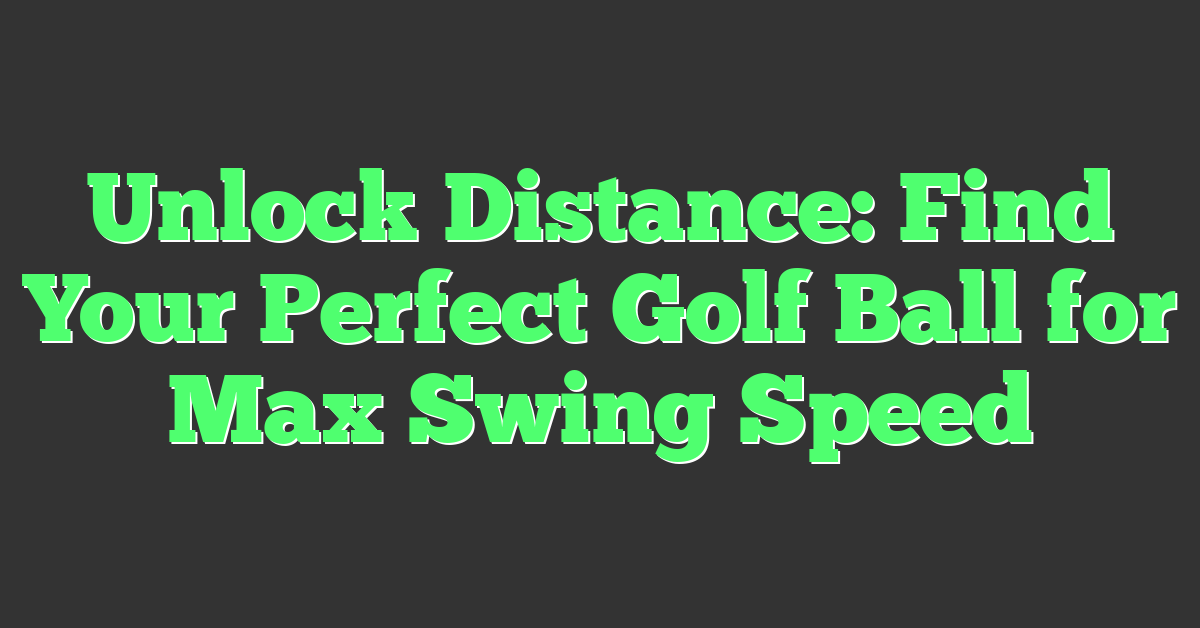Ever wondered why your golf buddy’s favorite ball just doesn’t do the trick for you? It’s all about the swing speed, folks. Finding the right golf ball that matches your unique swing can make a world of difference on the fairway.

What is swing speed in golf?
Picture this: You’re lining up that perfect shot, the breeze at your back and the fairway stretching out like a green ribbon before you. When you swing your club, the speed at which the clubhead moves through the air before striking the golf ball is what’s known as your swing speed. It’s measured in miles per hour (mph), and it’s a core factor in determining the distance your ball will travel.
Why Swing Speed Matters
Swing speed isn’t just about power; it’s about precision. It’s a reflection of how well you harness kinetic energy from your body through the club and into the ball. Higher swing speed translates into potentially greater distance – but only if you’re using the right equipment. If you’re a low handicap player or a seasoned pro, you might already have a good understanding of your swing speed. But knowing precisely how fast you swing could unlock the next level of your game.
Matching Ball to Swing Speed
To truly benefit from your swing speed, you’ve got to match it to the right ball. Here’s the deal:
- Lower swing speeds (below 85 mph): You’ll likely benefit from a softer, low-compression golf ball that will help you maximize distance despite slower clubhead velocity.
- Moderate swing speeds (85 to 105 mph): A medium-compression ball might be your sweet spot, balancing distance with a nice feel on the greens.
- Higher swing speeds (above 105 mph): You can handle a firmer, high-compression ball that will respond vigorously off the clubface for extra yards on your shots.
Understanding your swing speed opens up a tailored approach to your game, ensuring you’re not just slamming balls down the fairway but strategically placing them where you want. Remember, it’s not just about swinging faster; it’s about swinging smarter. By marrying your technique and the right equipment, you can optimize each stroke for an improved game. Keep this in mind as you select your next set of golf balls and visualize how they’ll complement your unique swing on the course.
How does swing speed affect ball performance?
When you’re out on the green, it’s not just your skill that determines how far and accurately the ball will fly — swing speed plays a pivotal role as well. Think of swing speed as the engine of your golf game; it’s the power that propels the ball, and it significantly influences ball performance.
Faster Swing Speeds
If you’ve got a fast swing, you’re dealing with the ability to compress the golf ball more on impact, leading to a greater energy transfer. Here’s what happens:
- The ball’s core is engaged, triggering a high-energy release.
- You achieve longer distances due to the extra energy.
- Lower spin rate on drives can result in straighter shots.
But remember, with great power comes the need for control. A harder swing isn’t always better. It needs to be paired with first-rate timing to ensure the sweet spot contact that’s so critical for maximizing performance.
Slower Swing Speeds
Don’t fret if your swing doesn’t rival the pros’. Slower swing speeds benefit from different ball characteristics:
- A softer core in the golf ball helps.
- There’s typically a higher spin rate, which can aid in control around the greens.
- Lower compression balls cater to slower swings, providing better feedback and performance.
So while you’re working on increasing your speed through training, there’s still plenty you can do to optimize your game. Choosing the right ball can actually compensate for some of the distance lost by a slower swing.
Matching Ball Type to Swing Speed
It’s essential to match the golf ball to your specific swing speed to get the most of every stroke. Various balls are crafted to deliver optimal performance for different speed ranges. Here’s what you should look for:
- High Swing Speeds: Tour-level balls with high compression ratings.
- Average Swing Speeds: Balls designed for a balance between distance and control.
- Low Swing Speeds: Low compression balls that enhance distance despite slower speeds.
By tailoring your choice of golf ball to your swing speed, you’re adjusting the equipment to work in your favor. This kind of strategic thinking is an underrated part of golf that too many golfers overlook.
Understanding the different types of golf balls
When you’re aiming to refine your game, knowing the type of golf ball that aligns with your swing speed is pivotal. It’s like choosing the right partner in a dance—the better the fit, the more graceful your performance will be.
Tour Balls are what you’ll often find seasoned players using, especially those with faster swing speeds. They’re constructed with multiple layers designed to provide a softer feel, control, and increased spin. With tour balls, you generate the precision needed for your approach shots, but remember, they do need a higher swing speed to unlock their full potential.
On the other side of the spectrum lie Distance Balls. If your swing is on the moderate side, these typically hard-cover balls with large, resilient cores might just be your ticket. They’re hardy, less expensive, and the focus here is on maximizing your distance by reducing spin and resisting hooks and slices.
For those with a penchant for finesse or a slower swing speed, Soft-Feel Balls strike the right balance. Their low compression rating means the ball deforms more on impact, thereby requiring less force to achieve sufficient energy transfer. You’ll notice these balls offer control around the greens and a softer touch.
Diving further in, it’s important to talk about golf ball compression. The compression rating of a ball measures how much it will compress when hit. Balls with a Low Compression Rating require less force to compress, making them ideal for slower swing speeds. Conversely, High Compression Balls necessitate a stronger impact, more suitable for golfers with a tour-level swing speed.

Lastly, don’t forget about Spin Control Balls. These gems can add some wizardry to your short game. They’re engineered to lower spin while you drive but provide more control when you need to get close to the pin. It’s about understanding your game and choosing a ball that compliments your play style.
Remember, the quest for the perfect golf ball is about matching your equipment to your style of play. So equip yourself with the knowledge and perhaps experiment a little. You might just find your game transformed on your next outing to the green.
Matching your swing speed to the right golf ball
When you’re out on the course, every detail counts toward shaving off those extra strokes. You know that your swing speed is central to the game, but figuring out how it translates to your choice of golf ball can make a world of difference.
Swing speed is more than a number; it’s a reflection of your unique style and strength. Typically, golfers with faster swing speeds exceed 105 mph, while moderate swing speeds hover around 85-105 mph, and slower speeds fall below 85 mph. Here’s a quick guide to matching golf balls to your swing:
- Fast Swing Speeds (Over 105 mph): You’ll want a ball that can keep up with your power. Look for tour balls designed with a higher compression. These will give you the control you need without sacrificing distance.
- Moderate Swing Speeds (85-105 mph): A balance of distance and feel is critical. Consider distance balls that offer a decent compression rate to help maximize your impact.
- Slower Swing Speeds (Below 85 mph): Soft-feel balls are your best bet. With lower compression, they compress more easily on impact, helping to add that extra bit of distance.
Remember, it’s not just about picking a ball and sticking with it. Variable conditions on the course can demand adjustments to your choice. Keep an eye on factors like the weather, the roughness of the greens, and the firmness of the fairways.

Testing different golf balls during your practice rounds is a practical approach. Pay attention to how each ball performs off the tee, on the approach, and around the green. Track the ball’s behavior in the wind and note any significant variations in distance or control.
Lastly, don’t underestimate the importance of personal feel. If a ball isn’t meshing with your playstyle, even if the specs are a “perfect match,” try another. The right ball feels like an extension of your club, smooth on impact and consistent in flight. Trust your experience and let your game speak for itself.
Testing and adapting to find the best golf ball for your swing speed
As someone who’s spent their fair share of time on the greens, you know the devil’s in the details. Choosing the right golf ball is much like selecting the ideal club; it requires experimentation and attention to how your choices play out in real-world conditions.
Start with a practice session at your local driving range and focus on how different golf balls respond to your swing. Distance is an obvious metric, but trajectory, spin, and feel are just as crucial. If possible, take a selection of balls that suit your swing speed range and hit them under variable wind conditions and lies. This will give you a broader understanding of their performance.
Keep track of your shots with each type of ball. It’s the small differences you’ll notice over time that can signify whether a ball complements your game. Here’s a simple way to organize your findings:

| Golf Ball Type | Distance | Trajectory | Spin | Feel |
|---|---|---|---|---|
| Tour | xxx yds | High | High | Soft |
| Distance | xxx yds | Mid | Low | Firm |
| Soft-Feel | xxx yds | Low | Mid | Very Soft |
On-course testing is equally valuable. During a casual round, commit to playing a different ball on the front and back nine. You’ll see how each reacts to the actual pressures of play, from tee shots needing maximum carry to short games demanding finesse around the greens.
Remember that adaptability is a golfer’s ally. Over time, your swing speed might change, or you might update your equipment. It’s vital to reassess your choice of ball when these shifts occur. Stay alert to how your ball is performing and always be willing to go back to the drawing board.
The journey to optimize your golf ball choice never really ends, but it’s a satisfying puzzle to piece together. Each round and each swing bring you closer to understanding the subtle intricacies that define your unique path to a lower score. Keep at it, and you’ll find that your diligence on the course often pays off in the form of improved confidence and control.
Conclusion
You’ve got the insights and you’re ready to hit the range. Remember, finding the right golf ball for your swing speed isn’t a one-and-done deal. It’s an ongoing journey that evolves with your game. So grab a sleeve of different balls and see what works for you. With each swing, you’re not just driving a ball down the fairway—you’re fine-tuning your play. And when you finally settle on the ball that complements your swing just right, you’ll feel that sweet spot of confidence and control. Now go out there and enjoy the game with your newfound knowledge!










